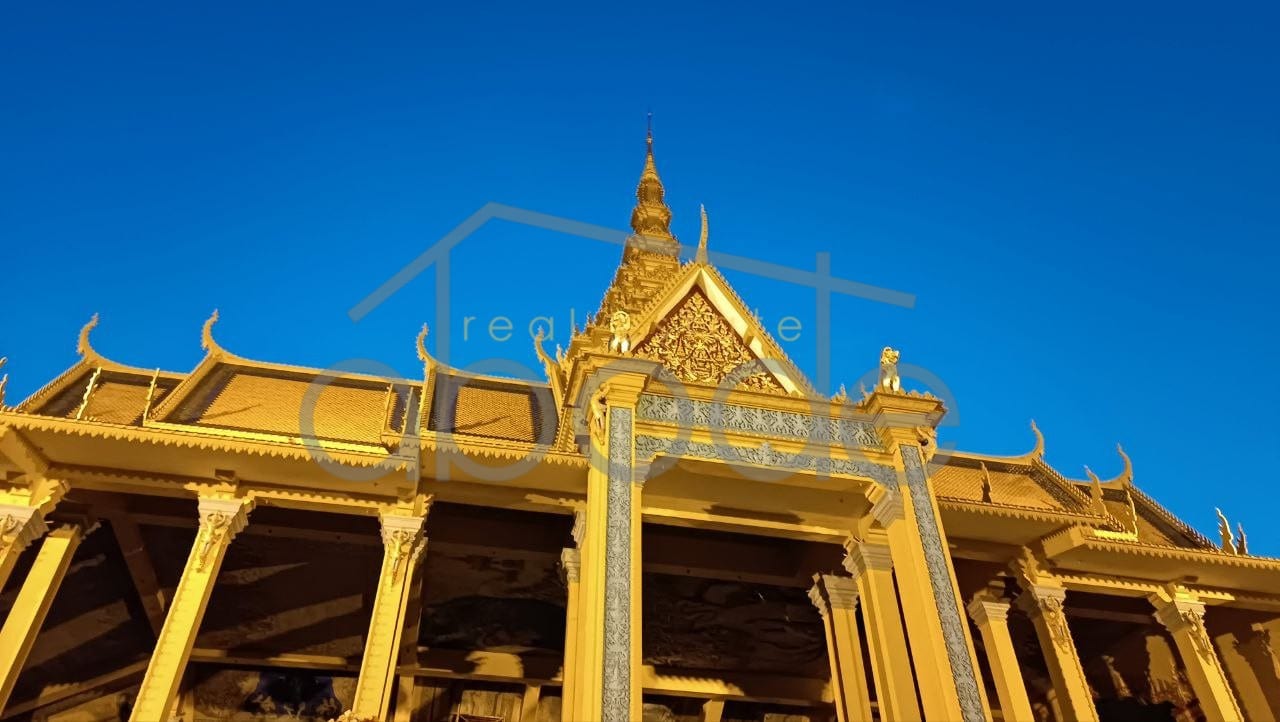The southern area of the Royal Palace complex is where you’ll find Wat Preah Keo Morakot (Silver Pagoda).
The pagoda’s previous name was Wat Uborsoth Rotannaram since the King performed his religious rituals there every Buddhist Silas Day.
The Majestic King Norodom Sihanouk, only stayed there for a year until he embraced the monastic life on July 31, 1947 and the royal family and government representatives still hold Buddhist rites there.
Monks from different pagodas including Wat Unaloam and Wat Botumvattey are invited to the ceremonies when the King celebrates Buddhist rituals.
Preah Vihear Preah Keo Morakot is the common name given to the pagoda by tourists because it is devoid of monks.
Preah Vihear Preah Keo Morakot was originally constructed with brick and wood (1892 – 1902) by King Norodom based on the architectural style of Cambodia and on February 5, 1903, a Banhchos Khan Seima celebratory ceremony was held.
Renovations to the Silver Pagoda of the Royal Palace
Queen Kosamak Neary Rath requested that the temple be renovated after it later sustained damage.
It was torn down and rebuilt in reinforced concrete on the same site in 1962 under the supervision of her son Samdach Preah Norodom Sihanouk.
Silver tiles filled the floor, and imported Italian glass stone encased the columns, however, the structure stayed the same.
Because the main Buddha statue features a rare emerald, known to Khmers as Keo Morakot, this temple called Pheah Vihear Preah Keo Morakot.
However, Westerners call it the Silver Pagoda due to its 5,329 real silver tiles that cover the floor.
This shrine is home to 1,650 works of art, mostly statues of Buddha in gold, silver, bronze, some with diamond embellishments.
They are gifts from the monarch, members of the royal family, dignitaries, and other worshippers at Preah Vihear Preah Keo Morakot.
There is also a gold Buddha statue in front of the throne weighing 90kg, adorned with 2,086 diamonds, in the crown the largest diamond.
Following King Norodom’s recommendation, King Sisowath commissioned this statue in 1904.
After his cremation, King Norodom ordered the gold coffin be melted down to create a Buddha statue honoring Preah Srei Araymetrey.
Preah Chin Raingsei Rachik Norodom is the name of this Buddha statue.
The Preah Keo Morakot, also known as the Emerald Buddha, is one of the Preah Vihear Keo Morakot’s most notable features.
It is located in the temple’s middle and sits atop a throne.
Buddhists consider the contents of a small glass cabinet to be the ashes of the Buddha.
In 1956, Head Monk Lvea Em, who resided at Wat Langka in Phnom Penh, carried the ashes from Sri Lanka.
A gold Buddha statue that was given in 1969 by Queen Mother of King Norodom Sihanouk, is displayed in an adjacent cabinet.
Naga guard this Buddha image, which symbolizes the time Buddha spent at Muchalonti Pond.
Ream Ke
A grand gallery surrounds the temple where the full Ream Ke epic is depicted in traditional paintings.
642 meters long and 3 meters high, these were created by 40 painters under the guidance of Oknha Tep Nimit between 1903 and 1904.
To see the complete story, guests must walk in a circle and because it does not exactly match the Indian Ramaya, viewers must examine it carefully.
Although the two versions are distinct, those familiar with the Indian Ramayana will have no trouble understanding the Cambodian Reap Ke.
La Khon Khaol and other sculpted figures like Sbek Thom and others also depict certain ideas, which are often used by astrologers to predict the future.
The paintings deteriorated over time due to weather, structural deterioration, and visitor vandalism.
In 1985, the governments of Poland and Cambodia worked together to preserve the paintings, however, this only lasted five years due to funding cuts.
The Cambodian government is currently exploring ways to preserve, protect, and restore this cultural heritage.
Prior to the Pali School’s opening on December 16, 1930, monks from Phnom Penh and other provinces took Pali language classes in the gallery.
Preah Vihear Preah Keo Morakot is surrounded by two stupas and a statue beneath the dome.
The ashes of King Ang Doung, King Sihanouk’s great-great grandfather, are kept in the stupas in the south.
King Shihanouk’s great-grandfather King Norodom’s remains are kept in the stupas in the north.
March 13th, 1980 saw the dedication of both stupas.
In 1875, a statue of King Norodom mounted a horse was erected, which was French King Napoleon III’s memento.
In 1892, it was retained in front of Preah Vihear Preah Keo Morakot, but there was no roof at the time.
King Sihanouk ordered the construction of the roof in King Norodom’s honor after Cambodia gained independence on November 11, 1953.
Keung Prah Bat
The footprints of the four Buddhas who attained enlightenment are kept in Keung Preah Bat (Kok Santhor, Neak Komonor, Kasabor, and Damonakodom).
Preah Srei Araynetrey, who Buddhists believe has not yet been born, is one of the four Buddhas in addition to the others.
According to their predictions, he will appear 5,000 years after the fourth Buddha enters Nirvana.
Borapat Kailasha of Phnom Khan Malineati
The artificial hill where the Buddha left his imprints on a stone, is known as Phnom Khan Malineati Borapat Kailasha or Phnom Mondul.
A statue of the Buddha and the 108 blessings of life that the Buddha must experience before achieving enlightenment are located on the Phnom Mondul.
Kunthabopha Stupa
The ashes of Princess Norodom Kunthaboph, the daughter of King Norodom Sihanouk, were interred in the Kunthabopha Stupa, constructed in 1960.
She passed away from dengue fever at the age of 4 years.
The old Banteay Srei temple in Siem Reap served as inspiration for its style.
A bell hall may be found west of Preah Vihear Preah Keo Morakot which signals the Silver Pagoda’s opening and closing during various festivities.
The monks who studied Pali in the palace used to be summoned by the bell as well.
Sutta Pitaka
There is a structure housed in the north in which the Sutta Pitaka is housed.
The primary Buddhist canon of scripture is the Tipitaka, among them the Sutta Pitaka which contain the dialogues between Buddha and others.
Five groups of texts make up this collection:
- the Digha Nikaya (long discourses),
- the Mijjhima Nikaya (medium discourses),
- the Samyutta Nikaya (grouped discourses),
- the Anguttara Nikaya (discourses on numbered topics), and
- the Khuddaka Nikaya (miscellaneous texts).
The Dhammapada (religious words) is a distillation of the Buddha’s teachings on mental discipline and morality.
The Jatakas, which contain stories of the Buddha’s previous lives, are particularly well-liked among the fifth group.
More than 225 rules make up the Vinaya Pitaka, the code of monastic discipline, which directs the behavior of Buddhist monks and nuns.
Each is accompanied by a narrative that explains the genesis of the governing principle.
The rules are listed in order of the magnitude of the offense that results from breaking them.
Abhidharma Patika
The Abhidharma Patika includes classifications and discussions from the fields of philosophy, psychology, and doctrine.
It is made up of seven works and feature a glossary of vocabulary, classifications of psychological processes, and analyses of metaphysics.
Shiva’s mount Nandi is also housed in the building.
In 1983, this person’s remains were discovered buried in Kandal province’s Koh Thom area and is thought to contain 80% silver.






